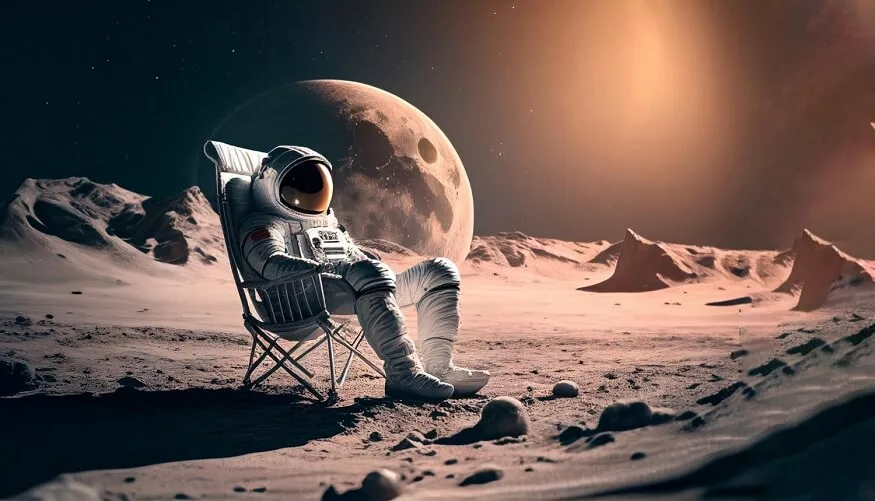Spacesuits are complex, multi-layered garments that provide astronauts with life support and protection against the unforgiving conditions of space. They serve several essential functions. Now, let’s delve into how spacesuits accomplish these critical functions with examples:
Also Read: India’s milestones in space exploration
1. Pressure:
There is no air pressure in the space environment, hence it is space. Without adequate protection, an astronaut’s body fluids would boil at extremely low pressure, resulting in a fast possibly dangerous decompression. Spacesuits maintain a constant pressure, often at 4.3 pounds per square inch, which is similar to Earth’s atmospheric pressure at a height of around 30,000 feet.
Example:
Spacesuits achieve pressure control through a rigid torso structure often referred to as the Hard Upper Torso. The HUT maintains a constant pressure around the astronaut’s chest and abdomen, effectively countering the vacuum of the space environment. A soft lower torso section provides flexibility for movement while maintaining pressure integrity.
2. Breathing:
There is no breathing air in the space environment, therefore astronauts must rely on a supply of oxygen to breathe. A life support system delivers a constant flow of oxygen and eliminates exhaled carbon dioxide in spacesuits.
Example:
The Primary Life Support System (PLSS) is a backpack-like component of the spacesuits that contains oxygen tanks, fans for circulating air, and a system for removing carbon dioxide. The astronaut breathes in oxygen supplied by the PLSS through a hose attached to their helmet. As they exhale, the carbon dioxide is removed from the suit and expelled into space.
3. Temperature Control:
Space experiences extreme temperature variations, ranging from hundreds of degrees Fahrenheit in direct sunlight to hundreds of degrees below freezing in the shade. Spacesuits must protect astronauts from these temperature extremes.
Example:
Spacesuits are equipped with a Thermal Control System that uses multiple layers of insulation, including Mylar and Kapton, to regulate temperature. Additionally, a Liquid Cooling and Ventilation Garment worn by the astronaut is filled with tubes carrying water. This water can be cooled or heated to maintain the astronaut’s body temperature within a safe range.
Also read : Best Tips To Get Children Interested In Space Science
4. Radiation Protection:
Space is full of potentially dangerous radiation, such as solar and cosmic rays, which can damage DNA and raise the risk of cancer. Spacesuits offer some radiation protection.
Example:
The layers of the spacesuits, including the outermost layer made of materials like Dacron and Neoprene-coated nylon, offer some shielding from radiation.
5. Micrometeoroid Protection:
Space is littered with tiny micrometeoroids travelling at high speeds. Even small impacts can puncture spacesuits and endanger an astronaut. Protection against micrometeoroids is crucial.
Example:
The Thermal Micrometeoroid Garment, the outer layer of spacesuits, is intended to give some protection against micrometeoroid collisions. It is constructed of many layers of strong materials that endure abrasion and puncture. The several layers of the TMG are designed to self-seal in the case of a puncture, preventing fast depressurization.
6. Communication:
Astronauts in harsh environments must communicate with mission control and their fellow crew members. Spacesuits are equipped with communication systems to facilitate this vital aspect of their work.
Example:
The helmet of spacesuits contains a visor with a gold-coated sunshade to protect the astronaut’s eyes from the intense sunlight. Inside the helmet, a microphone and speakers enable communication with other astronauts and mission control on Earth. Additionally, a communication system is integrated into the PLSS backpack for voice and data communication.
Also read : Amazing fun facts about Venus
Additional Features:
Spacesuits also incorporate several other features to enhance astronaut safety and functionality:
Helmet Visor: To defend against micrometeoroids and debris in harsh environments, the helmet visor is built of a robust, impact-resistant material. It also has a gold covering to protect the astronaut’s eyes from harmful sun radiation.
Gloves: Spacesuit gloves are specially designed to provide dexterity while maintaining pressure and protection. They often include multiple layers and are made from materials like Neoprene, Gore-Tex, and Kevlar.
Boots: Spacesuit boots are designed to provide stability and protection, with a rigid sole to prevent injury from sharp objects on the lunar or Martian surface.
Innovations in Spacesuits Technology:
Space agencies have consistently upgraded spacesuits technology throughout the years to increase astronaut safety and mobility. Here are some notable innovations.
- Advanced Mobility: Modern spacesuits, like NASA’s Advanced Crew Escape Suit (ACES), offer greater mobility for astronauts. They incorporate bearings at the joints to allow more natural movement.
- Integrated Helmet Display Systems: Some spacesuits now feature integrated helmet display systems, providing astronauts with important data, such as suit pressure and oxygen levels, directly within their field of view.
- Customization: Spacesuits are increasingly tailored to individual astronauts to ensure a snug fit, which improves comfort and safety.
- Lightweight Materials: Current research is directed at developing lighter, more flexible materials that retain their protective qualities.
- Next-Generation Spacesuits: Space organisations are working hard to construct next-generation spacesuits for journeys to the Moon, Mars, and beyond. These suits will include material, technological, and mobility improvements.
Also read : 5 Amazing fun facts about Mercury
Challenges and Future Directions:
While spacesuits have come a long way in providing protection and support for astronauts, challenges remain as space exploration pushes further into the cosmos:
- Extended-Duration Missions: As space missions to the Moon and Mars become more extensive, spacesuits must support humans for long amounts of time, demanding advancements in comfort and endurance.
- Radiation Protection: Improving radiation protection is a key task, particularly for deep space missions that would expose people to increasing quantities of cosmic radiation.
- Mobility: Finding a happy medium between protection and mobility is a constant problem, especially for missions requiring lengthy surface operations.
- Dust Reduction: Dust from the Moon and Mars can be abrasive and damaging to spacesuits. For long-duration missions, appropriate dust mitigation methods must be developed.
- Autonomous Suit Systems: Creating autonomous systems within the spacesuits to identify and respond to issues without depending on mission control from Earth.
Visit EuroSchool for more such exciting blogs!











